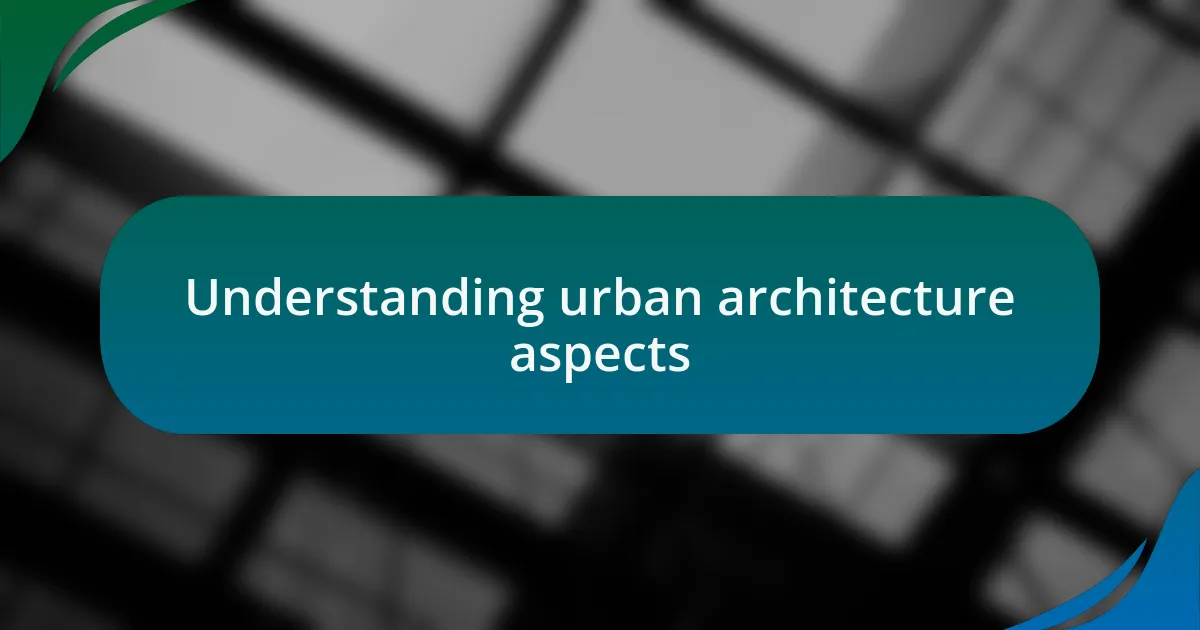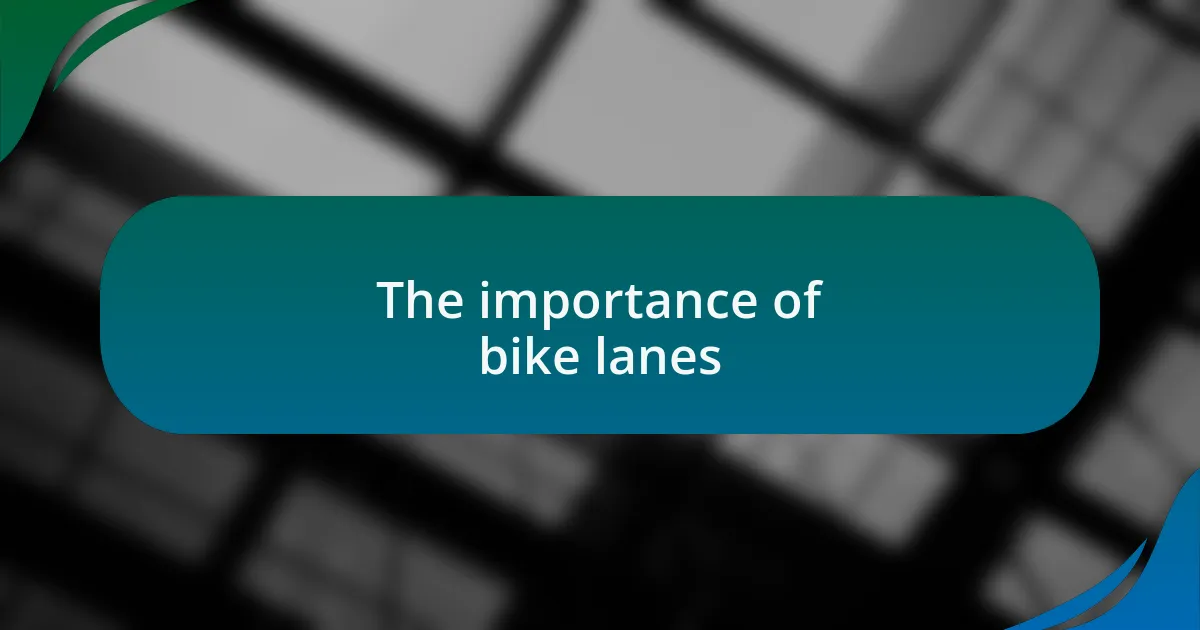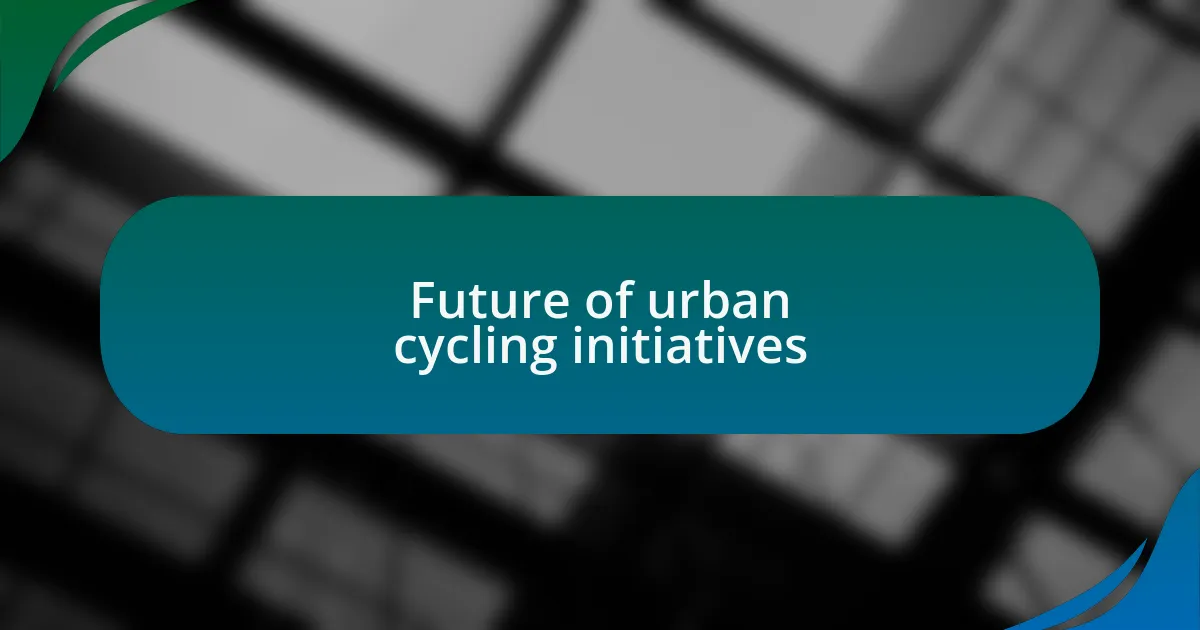Key takeaways:
- Urban architecture must balance aesthetics, community needs, and environmental sustainability, prioritizing pedestrian-friendly designs.
- Bike lanes are essential for safety, reducing traffic congestion, and promoting cycling as a viable transportation option, leading to improved air quality.
- Personal advocacy and community education are crucial in shifting perceptions about the importance of bike lanes and cycling infrastructure.
- The future of urban cycling initiatives includes integrating innovative technologies and promoting cycling events to enhance public engagement and sustainability.

Understanding urban architecture aspects
Urban architecture encompasses much more than just the aesthetics of buildings; it also reflects the social dynamics and functionality of a space. I remember walking through my city, feeling increasingly frustrated by the lack of bike lanes. It struck me that urban design should cater not just to cars, but to those of us who desire a more pedestrian-friendly environment—how many opportunities have we lost to create vibrant, connected communities?
When I think about urban architecture, I’m often reminded of the balance between space, community needs, and environmental sustainability. How do we find the right mix? In my experience, public spaces can act as a catalyst for community interaction, fostering a sense of belonging. Those moments spent in parks or safe cycling paths are essential, not just for recreation but for forming connections with our surroundings.
The relationship between architecture and mobility is vital and often overlooked. I’ve felt the excitement of riding down a newly installed bike lane, a tangible victory for my advocacy efforts. It made me realize that the design of our urban spaces has the power to change lifestyles, encouraging healthier choices. Isn’t it time we prioritize designs that invite us to move, explore, and engage?

The importance of bike lanes
Bike lanes are crucial for creating safe environments that encourage cycling as a viable mode of transportation. I vividly recall the first time I rode on a dedicated bike lane, feeling a sense of freedom and safety that was previously absent. The separation from motor traffic allowed me to enjoy my ride without the constant stress of cars whizzing by. Isn’t it inspiring to think that such simple infrastructure can transform how we experience our cities?
Additionally, bike lanes can significantly reduce traffic congestion and pollution. From my observations, as more people choose cycling over driving, the overall air quality improves, making our urban spaces more livable. I often find myself pondering: if we can reduce the number of cars on the road through better cycling infrastructure, what else can we achieve for our environment and community?
Finally, bike lanes foster inclusivity by catering to a diverse group of users, from commuters to recreational cyclists. I’ve seen firsthand how families use bike lanes to explore their neighborhoods, strengthening community ties and creating a vibrant atmosphere. Don’t you think that enhancing our urban spaces for everyone is the key to building a connected and engaged society?

My personal journey and experiences
As I embarked on my journey advocating for bike lanes, I was initially met with skepticism from friends and family. I remember one evening, passionately explaining my vision over dinner, and my brother shrugged it off as impractical. That moment ignited a fire in me; I realized that educating those around me about the benefits of bike lanes was just as crucial as the advocacy itself. The challenge of shifting perspectives intrigued me.
During community meetings, I often felt both excitement and frustration. I recall the first time I presented my ideas to the city council. My heart raced as I spoke, sharing the stories of cyclists I’d encountered who felt unsafe sharing the road with cars. Each story became a powerful reminder of the direct impact that safe bike lanes could have on individuals’ lives. Isn’t it fascinating how personal experiences can resonate much more than statistics?
As I began collaborating with local organizations, I found a sense of community that fueled my passion. One of my proudest moments was organizing a bike ride to demonstrate the need for safe lanes through a busy neighborhood. I still remember the joy on a child’s face as they pedaled beside their parent, laughter echoing in the air. It made me wonder—how many more families could experience this joy if we built safer infrastructure together?

Future of urban cycling initiatives
The future of urban cycling initiatives looks promising as cities begin to understand the importance of integrating bikes into their transportation systems. I vividly remember attending a recent urban planning conference where experts discussed concepts like micro-mobility and bike-sharing programs. It struck me how these initiatives not only enhance mobility but also align with sustainability goals, fostering a more eco-friendly urban environment.
I often find myself reflecting on how technological advancements can positively transform cycling in urban areas. For instance, smart bike lanes equipped with sensors could provide real-time data on traffic conditions, enhancing safety and efficiency. Isn’t it exciting to think about how innovation can propel community engagement and encourage more people to consider cycling as a viable option?
Moreover, I believe the promotion of cycling events can elevate public enthusiasm and awareness. I recall a city-hosted cycling festival where I met so many individuals who had never thought of biking as a daily commuting option. Sharing their excitement reignited my zeal for advocacy. How can we harness this energy to ensure that cycling is not merely an event but a staple in urban life? That’s the challenge we must embrace moving forward.